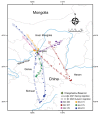Highly Pathogenic Avian Influenza A(H5N8) Clade 2.3.4.4b Viruses in Satellite-Tracked Wild Ducks, Ningxia, China, 2020
- PMID: 35447054
- PMCID: PMC9045446
- DOI: 10.3201/eid2805.211580
Highly Pathogenic Avian Influenza A(H5N8) Clade 2.3.4.4b Viruses in Satellite-Tracked Wild Ducks, Ningxia, China, 2020
Abstract
During October 2020, we identified 13 highly pathogenic avian influenza A(H5N8) clade 2.3.4.4b viruses from wild ducks in Ningxia, China. These viruses were genetically related to H5N8 viruses circulating mainly in poultry in Europe during early 2020. We also determined movements of H5N8 virus‒infected wild ducks and evidence for spreading of viruses.
Keywords: China; H5N8; Ningxia; birds; clade 2.3.4.4b; epidemic; highly pathogenic avian influenza A(H5N8) viruses; influenza; influenza virus; phylogeny; public health; respiratory infections; satellite tracked; subtype; viruses; wild ducks; zoonoses.
Figures

Similar articles
-
Multiple Introductions of Reassorted Highly Pathogenic Avian Influenza H5Nx Viruses Clade 2.3.4.4b Causing Outbreaks in Wild Birds and Poultry in The Netherlands, 2020-2021.Microbiol Spectr. 2022 Apr 27;10(2):e0249921. doi: 10.1128/spectrum.02499-21. Epub 2022 Mar 14. Microbiol Spectr. 2022. PMID: 35286149 Free PMC article.
-
Genetically Divergent Highly Pathogenic Avian Influenza A(H5N8) Viruses in Wild Birds, Eastern China.Emerg Infect Dis. 2021;27(11):2940-2943. doi: 10.3201/eid2711.204893. Emerg Infect Dis. 2021. PMID: 34670650 Free PMC article.
-
Novel H5N6 reassortants bearing the clade 2.3.4.4b HA gene of H5N8 virus have been detected in poultry and caused multiple human infections in China.Emerg Microbes Infect. 2022 Dec;11(1):1174-1185. doi: 10.1080/22221751.2022.2063076. Emerg Microbes Infect. 2022. PMID: 35380505 Free PMC article.
-
The genetics of highly pathogenic avian influenza viruses of subtype H5 in Germany, 2006-2020.Transbound Emerg Dis. 2021 May;68(3):1136-1150. doi: 10.1111/tbed.13843. Epub 2020 Sep 29. Transbound Emerg Dis. 2021. PMID: 32964686 Review.
-
The global prevalence of highly pathogenic avian influenza A (H5N8) infection in birds: A systematic review and meta-analysis.Microb Pathog. 2023 Mar;176:106001. doi: 10.1016/j.micpath.2023.106001. Epub 2023 Jan 19. Microb Pathog. 2023. PMID: 36682670
Cited by
-
Prevalence, evolution, replication and transmission of H3N8 avian influenza viruses isolated from migratory birds in eastern China from 2017 to 2021.Emerg Microbes Infect. 2023 Dec;12(1):2184178. doi: 10.1080/22221751.2023.2184178. Emerg Microbes Infect. 2023. PMID: 36913241 Free PMC article.
-
Prevalence of Antibiotic Resistance and Virulence Genes in Escherichia coli Carried by Migratory Birds on the Inner Mongolia Plateau of Northern China from 2018 to 2023.Microorganisms. 2024 May 26;12(6):1076. doi: 10.3390/microorganisms12061076. Microorganisms. 2024. PMID: 38930458 Free PMC article.
-
Ecological and Genetic Landscapes of Global H12 Avian Influenza Viruses and Biological Characteristics of an H12N5 Virus Isolated from Wild Ducks in Eastern China.Transbound Emerg Dis. 2024 Feb 22;2024:9140418. doi: 10.1155/2024/9140418. eCollection 2024. Transbound Emerg Dis. 2024. PMID: 40303124 Free PMC article.
-
Pathogenicity and Transmissibility of Goose-Origin H5N6 Avian Influenza Virus Clade 2.3.4.4h in Mammals.Viruses. 2022 Nov 5;14(11):2454. doi: 10.3390/v14112454. Viruses. 2022. PMID: 36366552 Free PMC article.
-
Highly Pathogenic Avian Influenza (HPAI) H5 Clade 2.3.4.4b Virus Infection in Birds and Mammals.Animals (Basel). 2024 May 2;14(9):1372. doi: 10.3390/ani14091372. Animals (Basel). 2024. PMID: 38731377 Free PMC article. Review.
References
Publication types
MeSH terms
LinkOut - more resources
Full Text Sources
Medical

